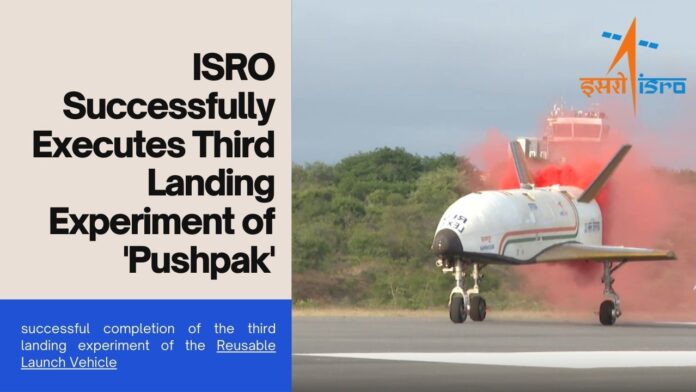The Indian Space Research Organisation (ISRO) celebrated a significant milestone with the successful completion of the third landing experiment of the Reusable Launch Vehicle (RLV LEX-03) named ‘Pushpak’ on Sunday. Conducted at 07:30 IST at the Aeronautical Test Range (ATR) in Chitradurga, Karnataka, the mission marks a hat-trick of successes for ISRO in the Reusable Launch Vehicle Landing Experiment (RLV-LEX).
ISRO chairman S Somanath expressed his congratulations to the team for their dedication in maintaining a streak of success in executing complex missions like the RLV-LEX. J Muthupandian served as the Mission Director, while B Karthik played a crucial role as the Vehicle Director for this mission.
The aim of the RLV LEX-03 mission was to replicate the approach, landing interface, and high-speed landing conditions typical of a vehicle re-entering from space. This successful mission showcased ISRO’s proficiency in acquiring essential technologies for the development of Reusable Launch Vehicles (RLVs).
Technical Achievements of RLV LEX-03 ‘Pushpak’:
- Autonomous Landing Capability: ‘Pushpak’ autonomously executed precise horizontal landing maneuvers under challenging conditions.
- Complex Maneuvers: The winged vehicle was released from an Indian Air Force Chinook Helicopter at 4.5 km altitude and autonomously corrected its course to land precisely at the runway centerline.
- High-Speed Landing: Despite a low lift-to-drag ratio aerodynamic configuration, ‘Pushpak’ landed at a velocity exceeding 320 kmph, showcasing advanced aerodynamic capabilities.
- Deceleration: After touchdown, the vehicle used a brake parachute to reduce velocity to nearly 100 kmph, followed by landing gear brakes for further deceleration.
- Ground Roll Stability: ‘Pushpak’ maintained stable ground roll using its rudder and nose wheel steering system, demonstrating precise control during the landing phase.
- Sensor Fusion: The mission utilized multisensor fusion technology, including Inertial sensors, Radar altimeter, Flush air data system, Pseudolite system, and NavIC, ensuring accurate navigation and landing.
Collaborative Effort and Future Prospects:
The RLV LEX-03 mission was a collaborative effort involving ISRO centers such as SAC, ISTRAC, SDSC-SHAR, along with support from the Indian Air Force (IAF), Aeronautical Development Establishment (ADE), and other key aerospace institutions and industrial partners. This success underscores ISRO’s capability to design and deploy reusable flight systems for multiple missions.
S Unnikrishnan Nair, Director of Vikram Sarabhai Space Centre (VSSC), emphasized that this achievement boosts ISRO’s confidence in critical technologies essential for future orbital re-entry missions.
The successful execution of the RLV LEX-03 mission reaffirms India’s prowess in space technology and marks a significant step forward in ISRO’s ongoing efforts towards developing advanced reusable launch capabilities.




